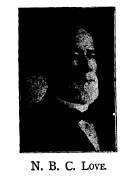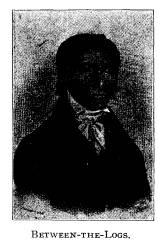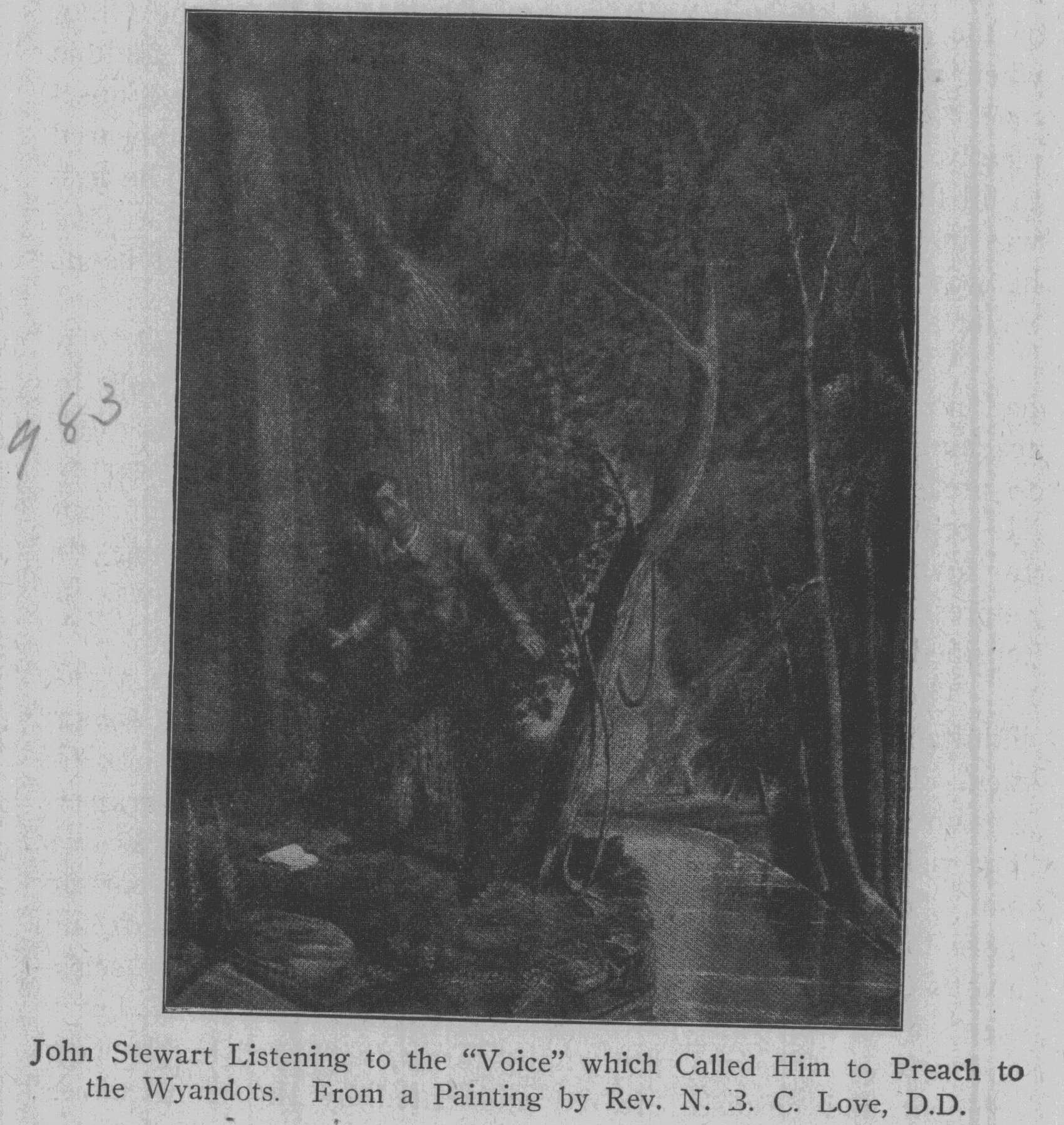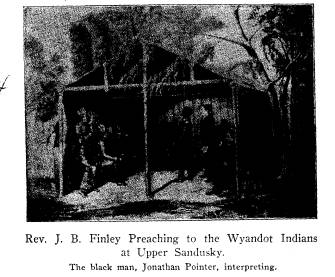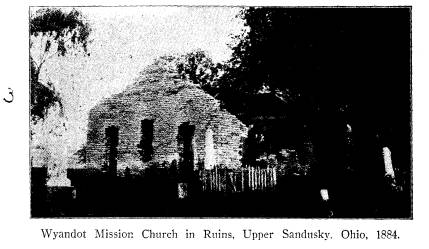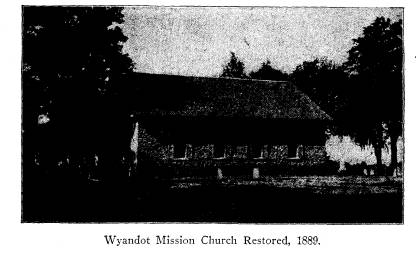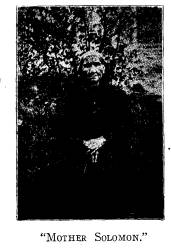Ohio History Journal
|
JOHN STEWART PIONEER MISSIONARY OF THE METHODIST EPISCOPAL CHURCH.
N. B. C. LOVE, D.D. The Methodist Episcopal Church from its organization in 1773 was missionary in its spirit. It made continuous efforts |
|
|
|
dots, and the founder of the first Methodist Episcopal Mission among the heathen. Before the advent of Stewart the most cruel and bloody practices obtained among the Wyandots. In this respect they were not different from the other Indian tribes of the North- west. The burning of Col. Crawford, when a prisoner, is evi- dence of this. Even the women and children participated in torturing him. We need not repeat the story here. The Wyan- dots were the leaders in this savage deed. Between-the-Logs, it is claimed, was a participant, and such were the people to whom Stewart carried the gospel of love and peace The Wyandots for a long period stood politically at the head of an Indian Federation of tribes and so were recognized by the United States Government in the treaties made with the Indians of the old Northwest Territory. The names of chiefs of the Wyandot nation appear first prominently on the treaty made at Greenville in 1795 between Vol. XVII-22. (337) |
|
338 Ohio Arch. and Hist. Society Publications. the Government and the Indians, Gen. Wayne acting for our Government. While the itinerant Bishops Asbury and McKendree and their worthy helpers were denied the honor of inaugurating the great missionary movement among the heathen, they are to be honored for their unselfishness in giving their co-operation and support to John Stewart, an humble mulatto layman, who had been converted through their preaching, and whom they recog- nized as having received the call of God. |
|
|
|
to desist and reform. Although failing several times in his ef- forts, he at last succeeded. He listened to the preaching of the Gospel by the Methodists and was converted. Finding no Baptist Society convenient, he united with the Methodist Episcopal Church. Here he was at home. The prayer and class meeting were delightful to him, and all his prejudices against the Methodists gave way. He also prospered in business and saved some money. The grand- father of Bishop McCabe was his class leader and personal friend. Stewart has been described to me by two pioneers who knew him well. He was a light mulatto, about five feet, eight inches high, weighing about one hundred and forty pounds; well formed, |
John Stewart. 339
erect in carriage, easy and graceful in
movement. His features
were more European than African. He had
a tenor voice, and
was gifted in song.
He often went into the fields or forests
to meditate, to study
the Bible and to pray. On Sabbath
evening he was in the edge
of the woods by the side of a rivulet
that ran into the Ohio,
when a voice from the sky seemed to say
to him in audible
tone, "Thou shalt go to the
Northwest and declare my counsel
plainly." As he listened and
looked, a peculiar halo appeared
to fill the Western sky. This summons
was repeated. The first
was in the voice of a man, the second
that of a woman. That
he was honest in the thought of this
calling there need be no
doubt.
A deep impression was made on his
astonished mind. He
had no thought of preaching; he felt he
would obey fully by
teaching and exhorting, but when a
friend told him he was called
to preach he rebelled, feeling he was
not prepared nor worthy.
He resolved to go to Tennessee, but
sickness came to him, and
for awhile his life was despaired of,
but finally recovering, the
impression that it was his duty to go to
the Northwest was in-
tensified.
The Northwest, beyond a fringe of
settlements, was a vast
illimitable wilderness, occupied by
savage beasts and as savage
men. He resolved to go, not for gain,
nor for fame, nor for
pleasure, but to save souls from the
bondage of heathen darkness.
The risks were many, but he felt that an
unseen hand was over
him. Starting on his journey, he knew
not whither he went any
more than Abraham of old. His friends
tried to persuade him
not to go, and having started, those
whom he met in the settle-
ments also tried such persuasion, or
laughed at his folly, but to
no purpose. The red men of the forest,
neglected by the Gov-
ernment and despised, feared and hated
by the frontiersmen,
were upon his mind. He believed they
were dear to the heart of
Jesus.
He went on, keeping towards the
Northwest, wading
streams, camping alone at night, unarmed
in the primeval for-
ests, enduring hunger and many other
hardships. After the
severe toil of days and exposure of
nights, he came to the vil-
|
340 Ohio Arch. and Hist. Society Publications.
lage of the Delawares-on the headwaters of the Sandusky River. The Indians extended to him the hospitality of their cabins. Here he held religious worship, singing, praying and telling the story of the dying love of Jesus until late at night, then, retiring, he fell asleep, feeling that his mission was ac- |
|
|
|
complished and that he would start on his homeward journey in a day or two. With the dawn of the morning, however, he awoke and heard an inward voice telling him to go farther. Having inquired the way, he started again on his pilgrimage. The first afternoon he came to the cabin of a white family |
John Stewart. 341
and was refused admittance by the wife
until the return of her
husband. Upon the husband's arrival,
while supper was pre-
paring, Stewart sang some sweet songs,
which charmed the
backwoodsman and his family. He offered
to hold services at
night, and the boys were sent post haste
by the father to the
few residents in the vicinity. Stewart
had about a dozen in his
congregation to whom he expounded the
Gospel, and sang Meth-
odist hymns, to their great
entertainment. The Divine Spirit
was in the word and several were
awakened and saved. Among
the number were the daughters of the
home in which he was en-
tertained. He tarried for several days,
holding services at night
and forming a class.
In a few days he found himself in Upper
Sandusky, an en-
tire stranger, without an introduction
to any one. He called at
the home of William Walker, sub-Indian
agent, who thought him
a fugitive from Slavery, but Stewart in
a sincere, artless manner
gave his history, including his
Christian experience. Mr. Walker
was convinced, and gave him words of
encouragement, directing
him to the cabin of Jonathan Pointer.
Pointer was a black man who had been
stolen by the Wyan-
dots when he was a child. He could
converse fluently in both
the English and Wyandot languages. Here
was a providential
helper in opening an "effectual
door" to the Divinely appointed
missionary of the Methodist Episcopal
Church.
Pointer was not favorably impressed with
Stewart, and
tried to dissuade him from his
undertaking by telling him of
the efforts of the Roman Catholic
missionaries and their com-
plete failure. He did not know that
"the kingdom of heaven
cometh not by observation." Indeed,
Jonathan Pointer was as
much a heathen as the Wyandots, and was
at that time pre-
paring to participate in an Indian dance
and religious feast.
Stewart wanted to accompany him, and
Jonathan reluctantly con-
sented. Stewart as a visitor sat in
silence and witnessed the dance.
When an interval of rest occurred, he
asked the privilege of ad-
dressing them on the purpose of his
visit which, with their con-
sent, he did, Jonathan interpreting and
rather enjoying the no-
toriety it gave him.
Here was a scene worthy the brush of the
artist. The first
342
Ohio Arch. and Hist. Society Publications.
heathen audience of hundreds of Indian
warriors in war paint
and gaudy costumes listening to a
messenger of the Methodist
Episcopal Church; Jonathan, too, in
paint and feathers, while a
mild-mannered mulatto told them the
purpose of his visit. Here
was Christian courage equal to that of
Fr. Marquette or any of
the old Jesuit Fathers of the Roman
Catholic Church. In this
Stewart evinced extraordinary courage
and faith in the Heav-
enly Father.
At the conclusion of his address he
invited all to shake
hands with him, and on motion of Chief
Bloody Eyes, all passed
by in single file and did so. An
appointment was made at
Jonathan's cabin for the next evening,
and by the light of the
cabin fire Stewart preached his first
sermon. This was late in
November, 1816.
Stewart met the Wyandots daily, Jonathan
interpreting and
saying: "What Stewart says may be
true, he did not know,
he only translated fairly." Many
were greatly interested and a
few awakened. The efforts of Stewart to
secure the conversion
of his interpreter were unceasing, and
his reward soon came in
an open profession on the part of
Jonathan, who became a firm,
outspoken believer. The soil of his
jovial African heart was thin
and did not bring forth perfect and
matured fruit. He was
naturally vain and sometimes was given
to drink, but God used
him as one of "the foolish things
of this world to confound
the wise." He was demonstratively
pious in church.
The missionary met with opposition from
the whites who
sold "fire water" to the
Indians. They maligned him, persecuted
and tried to scare him away: They said,
"he was no minister,
a fraud, a villain," and some of
the leading chiefs became his
enemies. Dark days had come. The
muttering of a storm was
heard, but nothing daunted, Stewart
sang, prayed, and going
from cabin to cabin found those who
received him and his words
gladly. The agent, William Walker,
Jonathan and a few other
leaders were his friends. Indians
prejudiced by Catholic teach-
ing joined the opposition. His Bible,
they said, "is not the true
Bible," but these questions being
left to Mr. Walker, the de-
cision was favorable to John Stewart.
Walker said there was
little difference between the Catholic
and Protestant Bibles, one
|
John Stewart. 343
being a translation from the Latin, the other from the Greek and Hebrew, and both from the same original documents; and that any layman called of God had the divine right to preach and teach. Thus through this layman and Government officer, Stewart was helped in his work. The Wyandots were superstitious, believing in magic, witchcraft, religious dancing and feasting. These things Stew- art opposed with Scripture and reason, and gave any who desired the opportunity to defend them. John Hicks, a chief, under- took this. "These things," he said, "are part of the religion of |
|
|
|
our forefathers handed down from ancient times, and the Great Spirit was the author of them, the same being adapted to their needs." Mononcue, then a heathen, endorsed what Hicks said. He also said, "The Bible is the white man's book and Jesus the white man's teacher; they were sent first to white men, why not to the Indians?" Stewart said, "In the beginning Jesus commissioned his disciples saying, 'Go ye into all the world and preach the Gospel |
344 Ohio Arch. and Hist. Society Publications.
to every creature.' This is as much for
you as for any others;
we bring His Gospel to you and if you
receive it not you shall
be damned. The Bible is for all. Christ
died for all that all
might be saved."
Stewart continued and Mononcue, Hicks
and others were
convicted and converted. Many others
embraced the truth.
These were among his first converts.
Having never been Ro-
man Catholics, their prejudices were
easy to overcome.
Crowds came to Stewart's meetings
nightly, and the work
of revival increased. Many of the
younger converts became,
under the leadership of Stewart, good
singers. Stewart's solo
singing was a special attraction to the
unbelievers. He always
sang with the spirit and with the
understanding also. While
he was not demonstrative nor vociferous,
he had the gift of per-
suasion and could logically impress the
truth on other minds.
He was not a scholar, but he had a good
common school educa-
tion and upon this foundation, through
his intercourse with
books, nature and God he became an
efficient workman. Sev-
eral of his sermons found in print,
although not fully reported,
evince the fact that he had clear
conceptions of theology, es-
pecially as relates to man as a sinner,
and a sinner to be saved
by Grace.
In February, 1817, Stewart felt
that something more radi-
cal must be done in order to bring about
the conversion of those
who were under his instruction. Their
convictions were more
of the head than of the heart. He and
those with him prayed
daily for the outpouring of the Holy
Spirit, and their prayer
was granted. Revival power came upon these heathen, and
there was deep and pungent conviction
for sins and real con-
versions. This work of grace aroused
opposition.
The heathen party arranged for a
"Thanksgiving Feast
and Dance." It was for the whole
Wyandot nation, and so
Stewart and his followers attended.
Stewart went with mis-
givings; he simply sat and looked on. To
his surprise his con-
verts joined in the dance, Mononcue with
others. Stewart had
protested against this, and he went away
discouraged, resolving
to leave them. He announced his purpose
and preached his
farewell sermon on the next Sunday from
Acts 20:30. This
John Stewart. 345
sermon, reported and printed by William
Walker, the writer
has read. Earnestly Stewart plead with
the converts to avoid
heathen practices, and warned the
heathen present, kindly but
earnestly, to flee from the wrath to
come.
He narrated his call to come to them and
his labors with
them, and told them they should see his
face no more. There
was general weeping, even the heathen
joining in the lamentation.
Stewart then addressed the chiefs and
principal men, while
silence reigned among the large audience
assembled in the coun-
cil house, as he bade all good bye.
On the suggestion of Mrs. Warpole, a
collection was taken
for Stewart, amounting to ten dollars.
He left and returned to
Marietta. A few remained faithful.
Heathenism and drunk-
enness held full sway. Only twenty men
of the Wyandot nation
did not drink intoxicants. Although
Stewart was away his
heart was with the Indians and after
only a few months, to the
joy of the Christian Indians, he
returned. During his absence
he wrote an excellent pastoral letter to
the little flock. Through-
out, his spirit and conduct evinced the
unselfishness of his mo-
tives.
With his return came an increase of
zeal, and power and
increased success crowned his efforts.
The work enlarged. It
was more than Stewart was able to do. A
prominent Methodist
minister of another denomination than
the Episcopal Methodists,
visited him and tried to have him change
his relationship, but
it was of no avail. He sent an account
of "The Lord's doings"
among the Wyandots to a session of the
Ohio Annual Confer-
ence and asked for a helper who could
assist him in preaching
and administration.
As nearly as can be ascertained, the
names of the mission-
aries and time are: John Stewart, 1816
to 1823; James Mont-
gomery, 1819; Moses Henkle, 1820; J. B.
Finley, 1821 to 1827
-part of this time as presiding elder;
Charles Elliot, 1822;
Jacob Hooper, 1823; J. C. Brook,
1825; James Gilruth, 1826-27;
Russell Bigelow served as junior
missionary in 1827 and in
1828 was in charge of the mission and of
the district as presid-
ing elder with Thomas Thompson, junior
missionary; B. Boyd-
son, 1830; E. C. Gavitt, 1831; Thomas Simms,
1832; S. P.
346
Ohio Arch. and Hist. Society Publications.
Shaw, 1835; S. M. Allen, 1837;
James Wheeler, 1839-1843;
Ralph Wilcox, 1843.
The teachers in the mission were: Miss
Harriett Stubbs,
Miss Margaret Hooper, Liberty Prentis,
Miss E. A. Gibbs,
Asbury Sabin, Jane Parker, matron, and
teacher of spinning,
weaving and domestic work, Mrs. Jane
Riley, L. M. Pounds
and the missionaries' wives.
Up to this time Stewart was an exhorter,
his license being
signed by Father McCabe, grandfather of
Bishop Charles C.
McCabe. The licence was given while
Stewart was in Marietta.
He now attended a Quarterly Meeting on
Mad River Cir-
cuit. Bishop George was present and
presided. "After a care-
ful examination, John Stewart was
licensed as a local preacher."
With money raised by Bishop McKendree a
tract of fifty-
three acres of land on the east side of
the Sandusky, near Har-
men's Mill, was bought for Stewart.
About this time Bishop
McKendree, in feeble health, came to the
mission on horseback,
from Lancaster, Ohio, and was
accompanied by J. B. Finley and
D. J. Soul, Jr. The Bishop was delighted
to find "the Lord
had a people among the Wyandots."
The money paid for the land was
collected by Bishop Mc-
Kendree at camp meetings and
conferences. In this is not only
an official recognition but a memorial
of the large heartedness of
this pioneer Bishop.
About 1820 Stewart married Polly, a
mulatto girl. She
was a devout Christian, and could read
and write. With her
he lived in his own cabin home and with
the help of his wife
and friends soon had enough from the
virgin soil, with some
money assistance from the conference, to
live in pioneer com-
fort.
Near the end of 1823, after a battle
with consumption, the
word spread among the Christians that
Stewart was dying; a
number of Christian chiefs and devout
men and women were
with him. Christmas and the New Year
were at hand. Stew-
art calmly exhorted all-told how the
Lord sustained him, and
gave his testimony to the power of
Christ to save. Holding his
wife's hand, he said to all, "Oh,
be faithful," and died. In an
|
John Stewart. 347
humble grave on his land he was buried, and for twenty years thereafter no stone marked his resting-place. But he was not forgotten. His grave was often visited, and the Indian youth were taught to place flowers on his grave each spring and summer time. In 1834 the Rev. James Wheeler, missionary, just before the Indians left for the West, had Stewart's remains taken up and reinterred at the southeast corner of the "old mission," and a free stone slab placed at his head with a suitable epitaph. This church was erected in 1824, the money, $1,333.33, be- |
|
|
|
ing donated by the Government through Hon. J. C. Calhoun, Secretary of War. Rev. J. B. Finley was the instigator in securing this, and he was made the custodian of the money pending its disposition in the erection of this church. The building later went into decay, and the gravestones were carried away piece-meal by relic hunters, until in 1886 all vestige of them was gone. A similar condition of affairs pertained with reference to the wood work and the furnishings of the Mission Church. In 1860 and 61 when these were in a fair state of preserva- tion, the writer, then a young man in his first station, Upper |
|
348 Ohio Arch. and Hist. Society Publications.
Sandusky, made a chart and diagram of the church and ceme- tery, the location of the buried dead, with copies of the epitaphs on each tombstone, which he preserved. The work of restora- tion was done with money-$2,000-donated by the Missionary Society of M. E. Church, by order of General Conference. The writer, as chairman of the restoration committee, had the honor of using this money in erecting once again, out of its ruins, the first mission church of Episcopal Methodism, and the first Prot- estant mission church in the Northwest Territory. When Charles Elliott was missionary, a log building was erected in |
|
|
|
which Stewart, Elliott and others preached, and here Harriett Stubbs taught the children. It was a temporary log building and, so far as we know, was not used exclusively as a church, and was not dedicated. During the session of the Central Ohio Annual Conference in September, 1889, the restored Mission Church was rededi- cated. There were several thousand more people present than could get into the house, so the services were held under the old oak trees which had sheltered the hundreds of Wyandots who had worship in the church. Dr. Adam C. Barnes, P. E., was chairman. Dr. P. P. |
|
John Stewart. 349
Pope, grandson of Russell Bigelow, led in prayer. Addresses were delivered by Bishop J. F. Hurst, Hon. D. D. Hare, Dr. L. A. Belt, Gen. W. H. Gibson, a historical address by the writer, and reminiscences by Dr. E. C. Gavitt, only surviving missionary, and a hymn in Wyandot sung by "Mother Solo- mon," a member in her childhood of the first mission school. Many were present whose parents or grandparents had been connected some way with the mission. |
|
|
|
Society of the Methodist Episcopal Church in 1819. And was not the mission school at Upper Sandusky the genesis of the Woman's Foreign Missionary work? If so, then all honor to Harriett Stubbs and Jane Parker and their worthy successors. Let the name of Stewart be placed in the list of the world's benefactors. May his sublime faith, clear conviction of the Di- vine presence, enthusiasm, endurance, patience and unselfish- ness, awaken in the hearts of each reader of these pages the spirit of emulation. |
